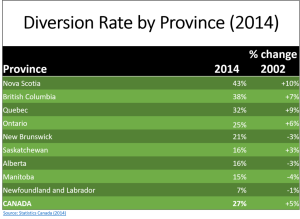For those promoting a more circular economy where materials are used again and again rather than made, used and dumped, the latest data from Statistics Canada provides a solid gut check on how far we have to go. Only 27% of our waste is currently being diverted from landfill or incineration. The “good” news is that at least our diversion rate has been steadily improving, up from 22% back in 2002.
The data measures the industrial, commercial, and residential waste streams of paper, plastic, glass, metals, textiles, organics (food), electronics, white goods such as fridges and appliances, and construction, renovation and demolition (CRD) materials like wood, drywall, doors, windows, and wiring. It excludes materials from land clearing and asphalt, concrete, bricks, and clean sand or gravel.
The only “good” news here is that the data, we believe, substantially understates the recycling that is going on in this country because it doesn’t include tonnages from provincial deposit/refund programs or the mostly paper materials that go from a retailer, say, direct to a paper recycling mill, rather than through a waste hauler or local government. Canada’s recycling success story (up 36% since 2002) will be the subject of a future blog.
In the meantime, we get to dwell on the bad news. As noted in our previous blog on this subject, Nova Scotia (and to a lesser extent British Columbia) are way out in front of everyone else. The diversion rates for New Brunswick, Alberta, Manitoba and Newfoundland and Labrador have declined over the last 12 years.

